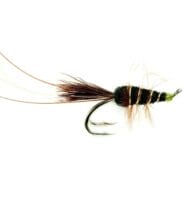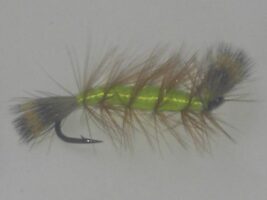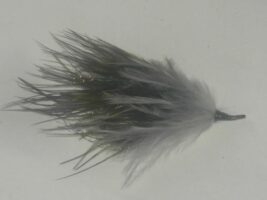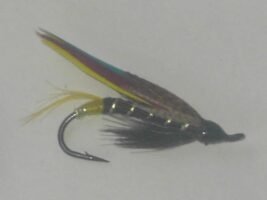Your cart is currently empty!
Black Francis Salmon Fly
The Black Francis Salmon Fly represents a deadly pattern in salmon fly design, particularly effective in slow-moving water, eddies, and below waterfalls. This sophisticated pattern was designed as a prawn imitation and has achieved remarkable success, particularly in Icelandic waters where it has dominated catches. Design Philosophy and Innovation?The pattern’s design reflects deep understanding of:…
Description
The Black Francis Salmon Fly represents a deadly pattern in salmon fly design, particularly effective in slow-moving water, eddies, and below waterfalls. This sophisticated pattern was designed as a prawn imitation and has achieved remarkable success, particularly in Icelandic waters where it has dominated catches.
Design Philosophy and Innovation?The pattern’s design reflects deep understanding of:
- Prawn imitation
- Profile presentation
- Material selection
- Light reflection
- Movement characteristics
Premium Materials and Construction?Traditional Materials:
- Quality hooks
- Black materials
- Mixed wing
- Fine thread
- Durable finish
Modern Adaptations:
- Enhanced durability
- Advanced techniques
- Specialized hooks
- Innovative finishes
- Contemporary materials
Technical Specifications
Hook Configuration:
- Style: Double/Treble
- Sizes: Various
- Strength: 2X-3X
- Finish: Black nickel
- Point: Sharp
Body Construction:
- Thread: Strong black
- Body: Black materials
- Wing: Mixed
- Profile: Prawn-like
- Action: Natural
Fishing Applications
Water Types:
- Slow pools
- Eddies
- Below waterfalls
- Various depths
- Different flows
Seasonal Effectiveness:
Spring:
- Early season runs
- High water conditions
- Cold water situations
- Variable depths
- Multiple presentations
Summer:
- Peak season
- Morning/evening fishing
- Bright conditions
- Technical fishing
- Deep running
Fall:
- Late season success
- Changed water
- Aggressive takes
- Multiple depths
- Various speeds
Advanced Fishing Methods
Presentation Techniques:
- Traditional Swing
- Down and across
- Speed control
- Depth management
- Line mending
- Angle adjustments
- Modern Adaptations
- Strip retrieve
- Pulse techniques
- Dead drift
- Sink and draw
- Multiple depths
Specialized Fishing Scenarios
The Black Francis Salmon Fly excels in these specific situations:
Eddy Fishing:
- Back current areas
- Seam transitions
- Depth changes
- Current breaks
- Holding zones
Waterfall Pools:
- Oxygenated water
- Turbulent zones
- Resting areas
- Feeding stations
- Depth variations
Optimal Conditions:
- Overcast weather
- Light rain
- Rising water
- Post-spate
- Temperature drops
Retrieval Patterns:
- Slow swing
- Short strips
- Sink-and-draw
- Varied speeds
- Depth control
The pattern is particularly effective when fished in slower water where salmon can get a good look at the fly. Its prawn-like profile becomes especially enticing when worked slowly through eddies and back currents, making it a go-to pattern for challenging fishing conditions.
Water Reading and Strategy
Key Factors:
- Current speed
- Depth evaluation
- Structure location
- Temperature
- Light conditions
Strategic Approaches:
- Entry point selection
- Drift planning
- Coverage patterns
- Depth control
- Speed adjustment
Environmental Adaptations
Light Conditions:
- Bright sunshine
- Overcast days
- Early morning
- Evening light
- Low light effectiveness
Water Clarity:
- Crystal clear
- Slightly colored
- Stained water
- Post-rain
- Variable visibility
Modern Variations
Size Adaptations:
- Standard sizes
- Scaled versions
- Custom ties
- Situation-specific
- Water-matched
Pattern Variations:
- Traditional style
- Modern materials
- Hybrid designs
- Color adaptations
- Seasonal options
Technical Considerations
Leader Setup:
- Length selection
- Tippet material
- Breaking strength
- Knot choice
- System balance
Equipment Matching:
- Rod weight (8-10wt)
- Line type
- Leader design
- Tippet selection
- Terminal tackle
Conservation and Durability
Material Selection:
- Environmental impact
- Longevity factors
- Strength requirements
- Replacement needs
- Storage considerations
Maintenance:
- Post-use care
- Storage methods
- Repair techniques
- Material preservation
- Long-term durability
Advanced Applications
Specialized Techniques:
- Deep presentation
- Structure fishing
- Cover presentation
- Technical mending
- Line control
Tactical Adaptations:
- Weather conditions
- Water levels
- Fish behavior
- Seasonal changes
- Time of day
Pattern Benefits
Design Advantages:
- Prawn imitation
- Improved visibility
- Better tracking
- Precise profile
- Natural appearance
Performance Benefits:
- Consistent results
- Natural movement
- Strike triggering
- Energy efficiency
- Versatile fishing
Advanced Water Reading
Current Analysis:
- Seam identification
- Depth transitions
- Structure influence
- Temperature breaks
- Holding lies
Strategic Planning:
- Coverage efficiency
- Presentation angles
- Rest periods
- Pattern rotation
- Time management
Seasonal Applications
Spring Tactics:
- Cold water techniques
- High water methods
- Early season approaches
- Fish behavior patterns
- Energy conservation
Summer Strategies:
- Peak season presentations
- Light penetration factors
- Temperature considerations
- Feeding patterns
- Time of day
Fall Methods:
- Pre-winter behavior
- Water temperature changes
- Migration patterns
- Aggressive triggers
- Weather influences
Future Developments
Emerging Trends:
- New materials
- Design refinements
- Tying techniques
- Fishing methods
- Pattern variations
Innovation Areas:
- Material technology
- Construction methods
- Presentation techniques
- Environmental considerations
- Performance enhancement
The Black Francis Salmon Fly represents the perfect fusion of prawn imitation and proven effectiveness. Its sophisticated engineering incorporates natural movement with strategic design elements, creating a pattern that consistently produces results across varying conditions. Whether fishing slow pools, eddies, or below waterfalls, this pattern delivers exceptional performance through its carefully calculated design elements and versatile presentation capabilities.
Additional information
| Hook size | 10, 12, 2, 4, 6, 8 |
|---|---|
| Hook type | Barbed Hooks, Barbless Hooks |







